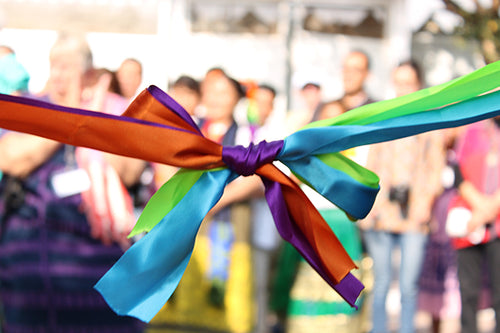
Victor y Flor Xuana, San Martin Tilcajete, Oaxaca
The Oaxacan tradition of woodcarving alebrijes goes back generations, but it is only in the past decade that the colorful figures have become popular with collectors worldwide.
What started with a few families has almost taken over the economy of three main pueblos that produce alebrijes. The dusty, rocky roads that used to lead into the villages have now been neatly paved. The prosperity from the carvings is a dramatic turn-around for these villages where 15 years ago, many people were struggling to make a living.
The carvings are made from the twisted branches of the copalillo tree, which grows on the hills around the valley. The wood has a sweet odor, and its copal resin has been burned in incense burners since ancient times. It is still an essential element at religious celebrations and such festivals as the Day of the Dead. Copal wood is easy to carve when it is green.
Today, as in the past, the carvers do most of their whittling with machetes or pocket knives. Then, they leave the carving to dry in the sun. After three days, it becomes lightweight and sands to a smooth finish. Before painting, some carvers apply a sealer to the wood to protect it from insects; others recommend freezing the finished carving after purchase, to kill any eggs which may still be in the wood.
Manuel Jiménez from Arrazola, now over 80 years old, rich and famous in artistic circles, is usually credited with being the maestro who started the international craze for these woodcarvings.
Another famous family is the Xuanas. What started with a few families has almost taken over the economy of these three towns. The dusty, rocky roads that used to lead into the towns have now been neatly paved. The prosperity from the carvings is a dramatic turnaround for these villages where 15 years ago, many people were struggling to make a living.
There are no limits to the creativity of Victor and Flor Xuana of the much sought after Xuana family. They are particularly known for the miniscule dots they cover many of their pieces with. Their inspiration comes from farmyard animals, fireworks and the brilliant colors of their fiestas, wildflowers that grow in the desert, and sometimes from their wild dreams, too!.
The contours of the carving, and the exuberant use of acrylic colors reflect each carver's personality, mood and fancy. The work is usually a family affair. Typically, the men wield the knives, and the women and children do the sanding and painting.
One of the most interesting and unique alebrije carvings are earrings. Tiny hand-carved animals with hundreds of tiny dots decorating them.
Galeaa #5
San Martin Tilcajete, Oaxaca

